1920's - The Roaring Twenties
Flappers
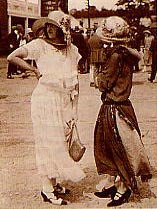 The wind of change that swept through society at the end of the First World War was nowhere more evident than in the unblushing emergence of the 'new woman'. The wind of change that swept through society at the end of the First World War was nowhere more evident than in the unblushing emergence of the 'new woman'.
The flapper -- she of the shingled hair, flattened chest, Art Deco dress or short skirt revealing most scockingly exposed knees, and rouged cheeks -- showed how women had been released from the bonds of Edwardian propriety.
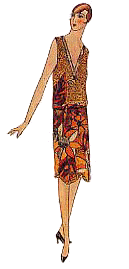 She was a young woman who had worked in the wartime industries or whose family had profited from the boom in materials and machinery needed to support the war effort. She was a young woman who had worked in the wartime industries or whose family had profited from the boom in materials and machinery needed to support the war effort.
Not for her the subservience of her mother's generation. Across society, from county daughters to shop-girls, a new confidence blossomed.
At the top end of the flappers' social scale, it was the 'Bright Young Things' who grabbed the headlines. The female contingent smoked cigarettes in public and dispensed with chaperones.
They joined in 'larks' with the boys, commandeering public transport, and digging up Piccadilly pavements with pneumatic drills for a jape.
Stories of their devil-may-care life-style made compelling reading for less well-off girls, who danced the Charleston in public and high-stepped at home to records of their favourite crooners.
This social change was accompanied by a change in political status. In 1918, women over 30 obtained the vote, and in 1928 everyone over 21 was enfranchised. Women and politics would never be the same. |
Crystal Sets
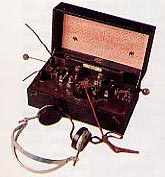 The crystal set -- named for the thin crystal of quartz or carborundum that supported a sensitive 'cat's whisker' -- made 'listening in' a craze in Britain.
On February 23, 1920, a handful of radio enthusiasts, hunched over their 'crystal sets', heard the first public radio broadcast in Britain when a ghostly voice in the Marconi Company's Chelmsford broadcasting station intoned the moving words: "The London, Brighton and South Coast Railway trains to Brighton leave London from Victoria Station."
This hardly fired the public imagination. But four months later, Dame Nellie Melba, the Australian soprano, broadcast from Chelmsford and the country sat up and listened.
The government-funded British Broadcasting Corporation was quick to provide competition. In 1922, the call-sign 'This is 2LO calling', from the BBC's base in Savoy Hill, started a revolution.
All over Britain, people started to build crystal sets and families clustered around them, sharing earphones. But by the mid-30's, crystal sets were scarcely to be seen, as valve sets took their place. |
Nightclubs
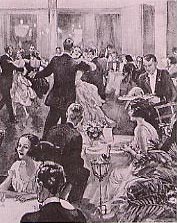 The 20's was the golden age of nightclubs. At the Trocadero, Bright Young Things would dance the night away, with the incentive of a 25-guinea clothes voucher - a lot of money in thosae days - given to the best-dressed lady. The award was made by Monsieur Paul Poiret, the Paris costumier, who was living in Britain, as he put it, to "study, criticize and suggest". The 20's was the golden age of nightclubs. At the Trocadero, Bright Young Things would dance the night away, with the incentive of a 25-guinea clothes voucher - a lot of money in thosae days - given to the best-dressed lady. The award was made by Monsieur Paul Poiret, the Paris costumier, who was living in Britain, as he put it, to "study, criticize and suggest".
When a cocktail party thrown by a Bright Young Thing began to lose its sparkle in the early hours, revellers would go on to a nightclub.
There they could Job-rot, Shimmy and Heebie-Jeebie to the music of the new jazz bands and carry on drinking, with only the minor nuisance of an occasional police raid to dim the lights.
In 1921, the wartime Licensing Act had been changed to allow drink to be served until 12.30 am, so long as it was accompanied by food.
As a result, nightclubs flourished, though often the only food available was sandwiches, and the curfew on alcohol was frequently ignored.
But illegality only seemed to add to the excitement and sheer naughtiness of the clubs, which were packed every night with an eclectic mixture of the aristocratic, the rich and the famous.
Despite the outrageous prices charged -- and the occasional piece of outrageous behaviour -- London's most successful clubs prided themselves on their exclusivity.
The Kit-Kat Club, for example, in the West End, was a favourite haunt of the smart set, and some 30 sons of the nobility were said to be members.
Without doubt, though, the most select and expensive of the nightclubs was The Embassy, in Old Bond Street. Presided over by Luigi -- who knew everyone -- its dance floor was always packed with the cream of society.
The Prince of Wales (later Edward V111) was a frequent visitor, together with the fast set of which King George V so disapproved.
There was a 'Queen of the London Clubs' too: Kate Meyrick, the former wife of a Brighton doctor, who ran nightclubs, "to pay for her daughters' education," she said.
She was so successful that three of them married peers of the realm. |
Trams
 A veto was imposed on tramways in Central London in 1872, but 30 years later, wiser counsels prevailed. The first electrical trams made their appearance on London's streets in 1903. A veto was imposed on tramways in Central London in 1872, but 30 years later, wiser counsels prevailed. The first electrical trams made their appearance on London's streets in 1903.
Soon, Britain was transformed, as miles of new track were laid. The clatter and jangle of points and overhead webs of criss-crossing wires quickly became a feature of city life.
Trams quickly became the people's mode of transport, running to a timetable for a set price. But trams had one fatal drawback: their routes were fixed. This very rigidity meant that they would be overtaken by free-ranging buses.
By 1939, the greater flexibility of the motor-bus had halved their numbers. This certainly pleased cyclists, for whom tram tracks were often a dangerous hazard -- especially in the wet.
Today, though, many environmentalists are concerned about the pollution spread by bus engines, and some transport planners believe that electrically powered trams may soon make a comeback. |
Airships
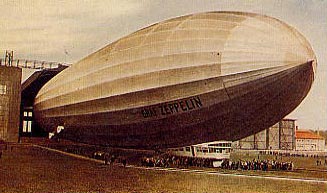 Imagine a form of travel in which you could not merely stretch your legs, but actually walk around in comfort -- and even dance to the music of a grand piano. Imagine a form of travel in which you could not merely stretch your legs, but actually walk around in comfort -- and even dance to the music of a grand piano.
In the 1920's this was not a dream -- it was the reality of the great airships, the ocean liners of the skies. Smoking rooms, dining rooms, lounges and even bedrooms offered a measure of style and comfort that today's massive jumbo jets cannot even begin to match.
The rigid airship had been invented and developed before the First World War by the German aristocrat Count Ferdinand von Zeppelin, and during the hostilities it had been put to a military use: airships of the Zeppelin Company carried out some 52 bombing raids.
When peace was restored, the huge, cigar-shaped gas balloons, with gondolas housing crew and passengers, were thought by most to represent the future of air travel. In Europe and America, 'blimps' were soon carrying commercial passengers from city to city on a regular basis.
Refinements in aerodynamics and interior design went on apace, and, in 1929, Germany's Graf Zeppelin (pictured) flew around the world in just 21 days, between August 7th and August 29th. It seemed the future of lighter-than-air transport was secure.
Britain had always lagged behind in the race, but the R101, the greatest airship in the British stable, seemed to promise better things.
Then in October, 1930, the 777-ft long flying leviathan crashed in France, killing 48 of her 54 passengers, as the unstable hydrogen in her balloon exploded.
This spelled the end of enthusiasm for airships in Britain: seven years later, in 1937, the fire that destroyed the Zeppelin-built Hindenburg dealt the final blow to the international fascination with lighter-than-air transport. |
Luxury Cars
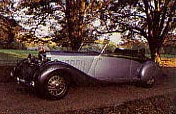 In this age of motorways and spaghetti junctions, when there are calls for fewer cars and higher taxes on petrol, it is difficult to remember that the first enthusiastic years of popular motoring seemed to promise a brave new world of freedom and the open road. In this age of motorways and spaghetti junctions, when there are calls for fewer cars and higher taxes on petrol, it is difficult to remember that the first enthusiastic years of popular motoring seemed to promise a brave new world of freedom and the open road.
For most, a car meant a Ford -- more than 5 million were sold world-wide by 1921 -- or later, an Austin Seven or a Morris Minor. But for the privileged there were luxury vehicles in plenty.
In 1922 Britain boasted 96 car-making firms, and few of their extravagant designs have been equalled. Names like Rolls-Royce, Bentley, Sunbeam and Daimler head the pantheon of classic cars to this day.
From overseas competitors, marques such as Italy's Lancia and Germany's Mercedes commanded both respect and exceptional prices.
A wealthy young man-about-town might take a girl out for a spin in the 1925 Lancia Lambda tourer, for example, with its high leather seats, streamlined running boards and large hand-lamps: playboys and princelings would prefer a Hispano-Suiza -- for preference the magnificent 8-litre Boulogne model.
"Magnificentlt made, perfectly proportioned, years ahead of its time and a joy to drive," was the Press verdict on this superb Spanish creation. Launched in Paris in 1919, it set the standard for car design, and still has a legendary reputation.
The most expensive British car of 1920 was the Leyland Eight, a technically advanced machine that initially went on sale for the massive sum of £2,500.
Rolls-Royce, however, were the acknowledged kings of British luxury cars, with an unrivalled reputation for reliability and exclusivity. From the stately Silver Ghost and its later incarnation, the Phantom, to their smallest -- but still large -- model, the 'Twenty', Rolls-Royce dominated the top end of the market.
|
Ocean Liners
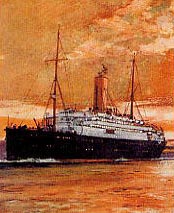 The great liners, the greyhounds of the Atlantic, were marvels of their time in terms of comfort, luxury and romantic mystique. The great liners, the greyhounds of the Atlantic, were marvels of their time in terms of comfort, luxury and romantic mystique.
Newsreels of their champagne and confetti arrivals and departures were staple cinema fare in the 20's and 30's, and nations cheered on their ships as they vied for the Blue Riband, the national prize for the fastest crossing.
Plain sailing could not always be guaranteed, for in 1925, the Berengaria, flagship of the Cunard Line, docked with her pride, if not her bulwarks, dented.
In an extremely rough crossing, £2,000 of crockery had been broken and 26 passengers injured.
The Royal Mail's Steamship Line's Arcadian was refitted and relaunched in June 1923 - previously the Asturias, she had been torpedoed in the English Channel in 1917. |
'The Green Hat'
The novelist who sums up the spirit of the flapper age is now a forgotten name, but in 1924 his shocking and melodramatic THE GREEN HAT catapulted Michael Arlen into celebrity.
It was a tale that combined much of what was lurid and attractive in the Jazz Age - fast women, fast cars, dissolute playboys and the disapproving old guard.
The wanton but noble heroine, Iris Storm, is desperately in love with Napier Harpenden, forbidden to marry him by his family, she is forced into two unhappy marriages and various affairs. Finally, she commits suicide by driving her yellow Hispano-Suiza into a tree.
|
|
|


